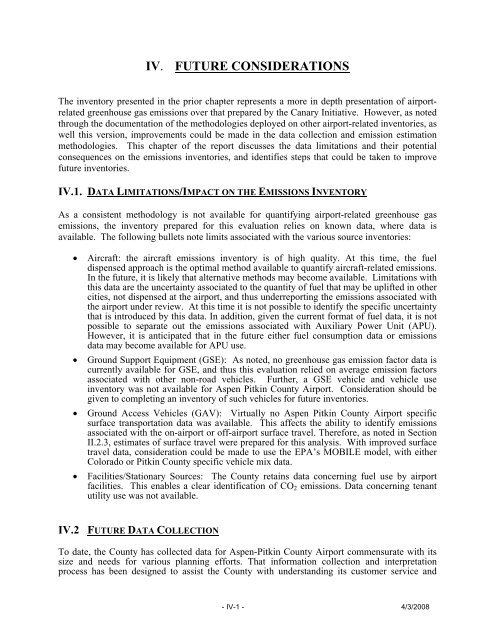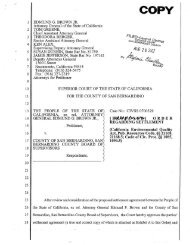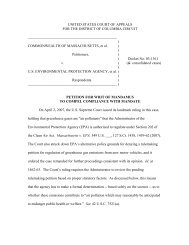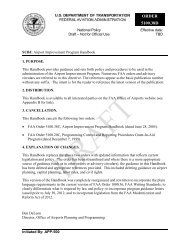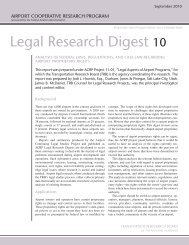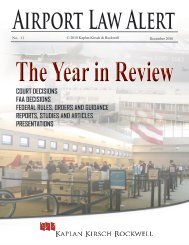Aspen-Pitkin County Airport Greenhouse Gas Emissions Inventory ...
Aspen-Pitkin County Airport Greenhouse Gas Emissions Inventory ...
Aspen-Pitkin County Airport Greenhouse Gas Emissions Inventory ...
Create successful ePaper yourself
Turn your PDF publications into a flip-book with our unique Google optimized e-Paper software.
IV. FUTURE CONSIDERATIONSThe inventory presented in the prior chapter represents a more in depth presentation of airportrelatedgreenhouse gas emissions over that prepared by the Canary Initiative. However, as notedthrough the documentation of the methodologies deployed on other airport-related inventories, aswell this version, improvements could be made in the data collection and emission estimationmethodologies. This chapter of the report discusses the data limitations and their potentialconsequences on the emissions inventories, and identifies steps that could be taken to improvefuture inventories.IV.1. DATA LIMITATIONS/IMPACT ON THE EMISSIONS INVENTORYAs a consistent methodology is not available for quantifying airport-related greenhouse gasemissions, the inventory prepared for this evaluation relies on known data, where data isavailable. The following bullets note limits associated with the various source inventories:• Aircraft: the aircraft emissions inventory is of high quality. At this time, the fueldispensed approach is the optimal method available to quantify aircraft-related emissions.In the future, it is likely that alternative methods may become available. Limitations withthis data are the uncertainty associated to the quantity of fuel that may be uplifted in othercities, not dispensed at the airport, and thus underreporting the emissions associated withthe airport under review. At this time it is not possible to identify the specific uncertaintythat is introduced by this data. In addition, given the current format of fuel data, it is notpossible to separate out the emissions associated with Auxiliary Power Unit (APU).However, it is anticipated that in the future either fuel consumption data or emissionsdata may become available for APU use.• Ground Support Equipment (GSE): As noted, no greenhouse gas emission factor data iscurrently available for GSE, and thus this evaluation relied on average emission factorsassociated with other non-road vehicles. Further, a GSE vehicle and vehicle useinventory was not available for <strong>Aspen</strong> <strong>Pitkin</strong> <strong>County</strong> <strong>Airport</strong>. Consideration should begiven to completing an inventory of such vehicles for future inventories.• Ground Access Vehicles (GAV): Virtually no <strong>Aspen</strong> <strong>Pitkin</strong> <strong>County</strong> <strong>Airport</strong> specificsurface transportation data was available. This affects the ability to identify emissionsassociated with the on-airport or off-airport surface travel. Therefore, as noted in SectionII.2.3, estimates of surface travel were prepared for this analysis. With improved surfacetravel data, consideration could be made to use the EPA’s MOBILE model, with eitherColorado or <strong>Pitkin</strong> <strong>County</strong> specific vehicle mix data.• Facilities/Stationary Sources: The <strong>County</strong> retains data concerning fuel use by airportfacilities. This enables a clear identification of CO 2 emissions. Data concerning tenantutility use was not available.IV.2 FUTURE DATA COLLECTIONTo date, the <strong>County</strong> has collected data for <strong>Aspen</strong>-<strong>Pitkin</strong> <strong>County</strong> <strong>Airport</strong> commensurate with itssize and needs for various planning efforts. That information collection and interpretationprocess has been designed to assist the <strong>County</strong> with understanding its customer service and- IV-1 - 4/3/2008


